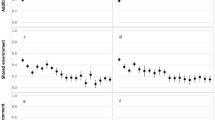Abstract
Longitudinal data for height (length) between birth and 2 years of age were examined for 690 Dutch Registry twin pairs. A two-stage analysis was performed, where individual growth curves were first fit to available data for each subject using a linear multiple regression procedure and estimated individual growth curve parameters were then subjected to multivariate biometrical analysis. Quadratic polynomial curves were found to adequately represent observed growth patterns for the majority of cases (median R2=.98). A specific scalar model of sex limitation best characterized individual variation in growth curve parameters. That is, there was significantly greater genetic variation for boys than for girls in both the predicted length and rate of growth at 1 year of age and the amount of deceleration in individual growth curves across age.
Similar content being viewed by others
References
Akaike, H. (1987). Factor analysis and AIC.Psychometrika 52:317–332.
Bentler, P. M., and Bonnet, D. G. (1980). Significance tests and goodness of fit in the analysis of covariance structures.Psychol. Bull. 88:588–606.
Cudeck, R., and Browne, M. W. (1983). Cross-validation of covariance structures.Multivar. Behav. Res. 18:147–167.
heath, A. C., Neale, M. C., Hewitt, J. K., Eaves, L. J., and Fulker, D. W. (1989). Testing structural equation models for twin data using LISREL.Behav. Genet. 19:9–36.
Johnston, F. E., Wainer, H., Thissen, D., and MacVean, R. (1977). Hereditary and environmental determinants of growth in height in a longitudinal sample of children and youth of Guatemala and European ancestry.Am. J. Phys. Anthropol. 44:468–475.
Joreskog, K. G., and Sorbom, D. (1989).LISREL VII 2nd ed., Scientific Software, Inc., Mooresville, IN.
Loehlin, J. C. (1987).Latent Variable Models, Lawrence Erlbaum Associates, NJ.
Neale, M. C., and Martin, N. G., (1989). The effects of age, sex and genotype on self-report drunkenness following a challenge dose of alcohol.Behav. Genet. 19:63–78.
Vandenberg, S. G., and Falkner, F. (1965). Hereditary factors in human growth.Hum. Biol. 37:357–365.
Vlietinck, R., Derom, R., Neale, M. C., Haes, H., van Loon, H., Derom, C., and Thiery, M. (1989). Genetic and environmental variation in the birth weight of twins.Behav. Genet. 19:151–161.
Welch, Q. B. (1970). A genetic interpretation of variation in human growth patterns.Behav. Genet. 1:157–167.
Willett, J. B. (1988). Questions and answers in the measurement of change. In Rothkopf, E. Z. (ed.),Review of Research in Education, Vol. 15 American Educational Research Association, Washington, DC.
Wilson, R. S. (1984). Twins and chronogenetics: Correlated pathways of development.Acta Genet. Med. Gemellol. 33:149–157.
Author information
Authors and Affiliations
Additional information
This research was supported in part by a Helen Putnam Visiting Scholarship award to Laura Baker while at the Henry Murray Research Center at Radcliffe College.
Rights and permissions
About this article
Cite this article
Baker, L.A., Reynolds, C. & Phelps, E. Biometrical analysis of individual growth curves. Behav Genet 22, 253–264 (1992). https://doi.org/10.1007/BF01067005
Issue Date:
DOI: https://doi.org/10.1007/BF01067005




